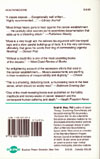The Cancer Industry: The Classic Expose on the Cancer Establishment
encontrar mi
Author: Ralph W. Moss, PhD |
Dr. Moss is a member of the Alternative Medicine Program Advisory Council of the National Institutes of Health. He has written numerous books questioning conventional cancer treatments, and advising alternative medicines. In this work, he questions the validity of the cancer industry.
This book is divided into four parts. The first part is entitled: "Proven Methods (That Often Don?t Work)." In this section, the author complains that the so-called war against cancer has accomplished nothing. He feels that doctors mislead the public by being falsely optimistic, using as an example the fact that they can?t even agree on a definition of the word "cure." The American Cancer Society defines a cancer cure as a five-year survival after diagnosis. But people may experience a recurrence after that. The author feels that this definition thus exaggerates the number of people being cured, and hence also exaggerates the benefit of conventional treatments. This section then goes on to argue against conventional treatments for cancer: surgery, radiation therapy, and chemotherapy. Surgery is deemed often unnecessary or too excessive, and the book states that "...the search for safer, more effective, and less traumatic methods of treating cancer is one of the imperatives of modern medicine." Radiation therapy, the book argues, is useless and has too many side effects: "...radiation therapy appears to be of limited value in the treatment of cancer." The author uses as evidence the fact that many surgeons do not believe in the value of radiation therapy. It is unclear why the author uses surgeons' opinions to prove his point, when he attempted to discredit them in the previous chapter. The book then moves on to chemotherapy, explaining that it has too many side effects to be useful. The author believes that chemotherapy research is propelled not by the desire to help patients, but by the avarice of drug companies.
The second, and largest, part of this book is entitled "Unproven Methods." The author feels that cancer cures are more likely to come from small, independent labs with innovative ideas. He then lists and explains a number of alternative treatments that he feels are promising, such as Coley?s Toxins, laetrile, hydrazine sulfate, and vitamin C. He argues that the cancer establishment suppresses these ideas, fearing that their therapies will be rendered obsolete.
Part three is a short section entitled "Prevention." The book blames doctors for not focusing on prevention, implying that they take this stance because prevention would render their services unnecessary. Industry is blamed for standing in the way of prevention by opposing regulation, fearing that regulation may threaten its profits.
Part four of the book, the final part, is entitled "The Cancer Business." As this title implies, this section discusses the author?s belief that "In the United States today, the direction of cancer management appears to be shaped by those forces financially interested in the outcome of the problem." He complains that doctors who administer therapy often have little control over how they treat their patients. There are too many outside influences: peer review committees within hospitals influence the course of treatment, insurance companies have much power, and the government exerts much influence (with agencies such as the Food and Drug Administration). He then uses Memorial Sloan-Kettering Cancer Center, the American Cancer Society, the National Cancer Institute, and the Food and Drug Administration as examples of how outside financial interests exert their power.
This book raises many interesting and important issues, such as the need for increased interest in prevention, the importance of independent labs, and the potential benefit of alternative treatments. However, while the author provides many quotes from notable physicians, he does not provide much evidence in the way of concrete facts and numbers. Also, it is important to note that a great majority of the references come from the 1970's, many from the 1950?s and 1960?s, and only a few from the 1980's. The opinions expressed in these references may thus be outdated.
This book is not recommended by OncoLink.

